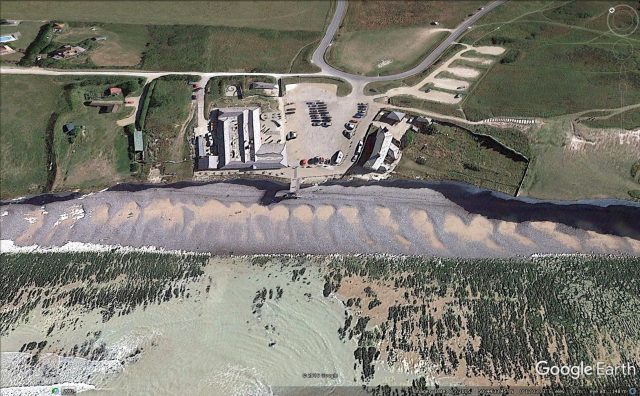8 November 2016
Recent increases in the retreat rate of chalk cliffs in southern England
Posted by Dave Petley
Recent increases in the retreat rate of chalk cliffs in southern England
One of the most spectacular landforms of the south of England are the famous high chalk cliffs. Perhaps best known as the sight that greets those arriving by sea to Dover, the chalk cliffs occur along the central and eastern part of the south coast, with the most spectacular examples being found in East Sussex:

The chalk cliffs of East Sussex via Pinterest
.
These cliffs actively erode, with large rockfalls being a key mechanism. We expect that the erosion rate of these cliffs will increase as sea level rise accelerates and the climate becomes more stormy. This effect can be modeled, but to be reliable these models need to be calibrated with historical data. But, reliable data to allow past cliff positions to be ascertained extends only 200 years at best, and has large errors until modern times.
Fortunately a solution is at hand. In recent years so-called cosmogenic isotope techniques have been developed that allow surfaces to be dated – or more precisely, the point at which a surface was created can be ascertained. As chalk cliffs retreat they leave a wave-cut platform at the base (this can be partially seen in the image above). Cosmogenic isotope dating can then be used on the surface. A transect across the platform should yield the youngest dates at the cliff toe (where the platform was most recently created) and the oldest dates out towards the sea. Thus, the age profile of the platform can be determined, which in turn gives the rate of retreat of the cliffs. This sounds very straightforward, but in reality it is fiendishly difficult. The most challenging elements are that the platform itself erodes downwards after it was created, and of course it is submerged by the sea and / or a beach for much of the time. This means that to ascertain reliable dates requires complex modeling of the results, but if that can be overcome then a great deal of insight can be gained.
In a paper just published in PNAS, Hurst et al. (2016) have dated the wavecut platforms at the toes of the East Sussex chalk cliffs using a cosmogenic technique, Beryllium 10 on exposed flints that sit within the chalk. In this area, the cliffs are currently retreating at rates of 10 to 80 cm per year, some of the highest in the UK. At Beachy Head no attempt is made to reduce coastal erosion with defences, although adjacent areas of coastline are protected. Two sections were dated, one at Beachy Head and one at Hope Gap.

Google Earth imagery of the chalk cliffs at Beachy Head. Note the wavecut platform
.
The headline from the study is that the erosion rate has changed drastically in recent times. If we take Beachy Head for example, the modern (i.e. post-1870) retreat rate is 22 cm per year, whilst the long term retreat rate is deduced to be 2.6 cm per year. Thus the retreat rate has increased in modern times by a factor of about ten. This is a dramatic change. Hurst et al. (2016) suggest that this is probably a result of an increase in wave energy delivered to the coast, possibly in part due to increased storminess and in part to a reduction in beach width (beaches protect the cliffs from wave action) due to coastal defences to the west, which have starved this section of coast of its supply of sediment.
The implications for the future are clear. This is a highly populated area, so infrastructure is at risk. This for example is the clifftop at Birling Gap, just along the coast to the west:

Google Earth image of the clifftop at Birling Gap.
.
But this area is a national park, so the effects may not be very dramatic. Elsewhere thie implications of this study may be more profound.
Reference
Martin D. Hurst, Dylan H. Rood, Michael A. Ellis, Robert S. Anderson, and Uwe Dornbusch. 2016. Recent acceleration in coastal cliff retreat rates on the south coast of Great Britain. PNAS. Published ahead of print, November 2016. doi:10.1073/pnas.1613044113
Similar posts that may be of interest:
- Remarkable coastal change from the recent UK storms
- Over a century of rockfalls on a coastal cliff at Nobbys Head, Australia
- Coastal erosion and residential property
- Coastal erosion as art
- Coastal erosion and climate change: Implications for the shoreline over the next century
- Coastal erosion – the last groyne problem


 Dave Petley is the Vice-Chancellor of the University of Hull in the United Kingdom. His blog provides commentary and analysis of landslide events occurring worldwide, including the landslides themselves, latest research, and conferences and meetings.
Dave Petley is the Vice-Chancellor of the University of Hull in the United Kingdom. His blog provides commentary and analysis of landslide events occurring worldwide, including the landslides themselves, latest research, and conferences and meetings.